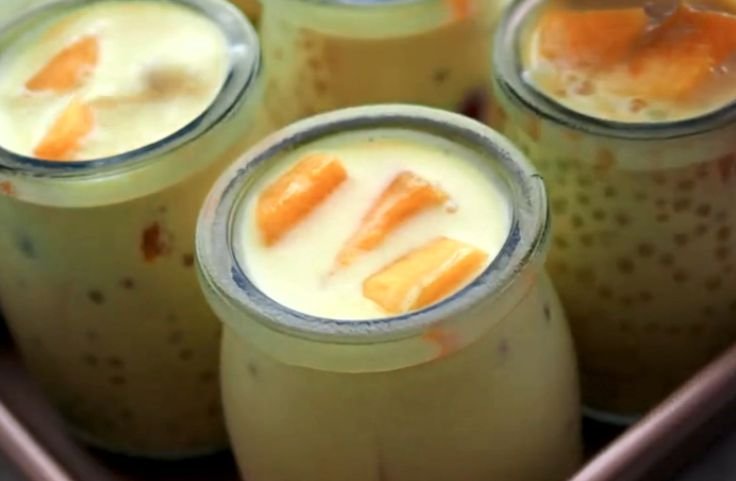Mango tapioca pudding recipe, particularly in its Thai-style preparation, is a quintessential dessert that captures the essence of tropical flavors and textures.
Thai-style mango tapioca pudding is a simple dessert that delivers bold flavor with minimal effort.
Ripe mango, creamy coconut milk, and chewy tapioca pearls come together to create a chilled treat that’s both refreshing and satisfying.
Common in Thai street food stalls, this dessert is easy to recreate at home with just a few pantry staples.
It’s a favorite during hot weather and perfect for rounding off a meal with something light but full of texture.
In this post, you’ll get a full breakdown of ingredients, step-by-step instructions, helpful tips to avoid mistakes, and easy variations if you want to switch things up.
Whether you’re cooking for yourself or serving guests, mango tapioca pudding is a dessert that delivers tropical flavor in every bite.
Recommended: The Many Tapioca Recipes
Table of Contents
- What is Thai-Style Mango Tapioca Pudding?
- Ingredients You’ll Need for Thai Mango Tapioca Pudding
- Step-by-Step Recipe Instructions
- Serving Tips
- Tips for Perfect Mango Tapioca Pudding
- Variations You Can Try
- Conclusion
- Frequently Asked Questions
What is Thai-Style Mango Tapioca Pudding?
Thai-style mango tapioca pudding is a refreshing dessert rooted in the flavors of traditional Thai sweets, especially reminiscent of mango sticky rice.
Unlike heavy, dairy-based Western puddings, this version uses coconut milk for a creamy texture and tropical depth.
Ripe mango adds natural sweetness, while chewy tapioca pearls offer contrast in every bite.
What makes it stand out is the balance of lightness, texture, and flavor.
The dish is typically served chilled and garnished with fresh mango slices or coconut cream for added richness.
It’s a simple yet flavorful treat that reflects the essence of Thai desserts, using minimal ingredients to create something memorable, satisfying, and easy to enjoy.
Related Posts
How to Make Tapioca Pudding at Home
Is Tapioca Pudding Good for You?
Can Diabetics Eat Tapioca Pudding?
Chocolate Tapioca Pudding Serving Ideas for Any Occasion
Is Tapioca Pudding Gluten-Free?
How to Make Dairy-Free Tapioca Pudding
What Does Tapioca Pudding Contain?
Ingredients You’ll Need for Thai Mango Tapioca Pudding
This pudding brings tropical flavor to your table with just a few simple ingredients.
Each one plays a key role in creating the creamy texture and fruity sweetness you’ll love.
Small Tapioca Pearls
These are the foundation of your pudding. You’ll need the small kind, those tiny white pearls that turn translucent once cooked. See more on small tapioca pearls here.
They soak up the coconut milk and turn chewy, giving you a soft bite in every spoonful.
Don’t rush them. Soak them first, then simmer until they’re clear with no white centers.
This step matters. If they’re undercooked, the texture won’t be right, and if overcooked, they’ll lose their bounce.
Ripe Mangoes
This is where the flavor hits. Go for ripe, juicy mangoes that are naturally sweet.
If you’re using fresh ones, pick those that feel soft when pressed gently.
The deeper the yellow or orange, the better. Slice them thin or cube them small, just make sure each bite gets some.
Frozen mangoes can work too, but thaw them fully before adding. Keep it fresh and vibrant.
Coconut Milk
You’ll want the thick, creamy kind. Full-fat coconut milk gives your pudding that rich base and smooth finish.
Shake the can well before opening. If you like things lighter, low-fat coconut milk will do, but the flavor won’t be as deep.
Avoid coconut drinks or watered-down versions. This is what brings the tropical flavor together with the mango and pearls.
Sweetener: Sugar or Palm Sugar
Use white sugar if you want a neutral sweetness. For something with more depth, go with palm sugar. It melts into the coconut milk and adds a slight caramel note.
Taste as you go; some mangoes are sweeter than others. Adjust the sugar depending on your mango and how rich you like your pudding.
Optional Toppings
Once the pudding is chilled and ready, finish it your way. Toasted sesame seeds give a light crunch.
A drizzle of thick coconut cream adds richness. Fresh mint lifts the flavors and adds color.
You could even toss on a few extra mango cubes for texture. These touches don’t just make it look good; they round out the flavor.
Related: How to Eat Tapioca Pudding as a Diabetic
Step-by-Step Recipe Instructions
This Thai-style mango tapioca pudding comes together in simple steps. With a bit of prep and attention, you can create a dessert that’s creamy, chewy, and full of tropical flavor.
Soak the Tapioca Pearls
Measure 1 cup of small tapioca pearls and soak them in water for 30 minutes.
This softens the pearls and helps them cook evenly. After soaking, drain and set aside.
Cook the Tapioca Pearls
Bring a pot of water to a gentle boil. Add the soaked pearls and cook for 15 minutes or until translucent. Stir occasionally so they don’t stick together.
Rinse and Cool the Pearls
Once the pearls are fully cooked and no white centers remain, drain and rinse them under cold running water. This stops the cooking and removes extra starch.
Make the Coconut Milk Mixture
In a separate pot, combine one can of full-fat coconut milk, half a cup of sugar, and a pinch of salt. Heat gently and stir until the sugar melts completely.
Combine Tapioca and Coconut Milk
Add the cooked pearls to the sweet coconut mixture. Cook on low heat for 5 to 10 minutes, stirring gently. Let the mixture thicken slightly before removing it from the heat.
Prepare the Mango
Peel and cut ripe mangoes. You can dice them for texture or blend into a smooth purée. Make sure the mango is sweet and fully ripe before using.
Assemble the Pudding
Spoon the coconut tapioca into serving bowls or glasses. Add mango on top or layer it in between. You can chill it for a firmer texture before serving.
Add Final Toppings
Top with extras like toasted coconut flakes, fresh mint, or a drizzle of coconut cream.
These toppings add flavor, texture, and a polished finish to your pudding.
Serving Tips
Serve mango tapioca pudding chilled or warm, depending on your mood or the weather.
Chilling it for two hours brings out deeper flavors and a firmer texture. Use clear glass jars or dessert bowls to show off the layers of creamy tapioca and bright mango.
Garnish with mint or toasted coconut for added flair. For an even better experience, pair it with Thai tea for a rich contrast or add coconut crisps for crunch.
Sticky rice can also make it more filling. The right serving choices, from temperature to presentation, turn this simple dessert into something memorable, both in taste and appearance.
Tips for Perfect Mango Tapioca Pudding
Mango tapioca pudding comes out best when you focus on the small details. From the fruit to the pearls to how you serve it, every step affects taste and texture.
Here’s how to get it right every time.
Pick the Right Mangoes
Choose mangoes that smell sweet and give slightly when pressed. Ataulfo or Haden varieties work well for their smooth texture and deep flavor.
Avoid fibrous mangoes that leave strings in your pudding. If using frozen mango, thaw completely and check for sweetness before blending or dicing.
Soak and Cook Tapioca Properly
Soak small tapioca pearls in water for at least 30 minutes. This helps them cook evenly and prevents hard centers. Simmer gently while stirring to avoid clumping.
Once translucent, rinse with cold water to stop cooking and keep the pearls separate and chewy for the best texture.
Control Sweetness and Texture
Always taste your coconut milk before sweetening, since some brands are naturally sweeter.
Add sugar or sweetened condensed milk gradually. Adjust coconut milk to control thickness, less for a thicker pudding, more for a creamier result.
Chill well to let flavors blend and texture settle before serving.
Make It Look Good
Use clear dessert bowls or glasses to show the contrast between the mango and tapioca layers.
Add diced mango or swirl in mango purée for color. Finish with coconut cream, sesame seeds, or mint.
These small touches add both visual appeal and extra texture with no extra effort.
Variations You Can Try
If you’re looking to change things up, mango tapioca pudding is easy to adapt.
From flavor blends to ingredient swaps, here are different ways you can make it your own.
Try a Vegan-Friendly Version
Swap dairy with full-fat coconut milk or almond milk to keep it plant-based.
Use natural sweeteners like maple syrup or agave for a smooth, clean flavor.
You still get that creamy texture and rich tropical taste without adding any animal products.
Chill the pudding well so the flavors come together, then serve it with fresh mango for a dairy-free dessert that doesn’t feel like a compromise.
Add Other Tropical Fruits
Mix diced pineapple, lychee, or passion fruit into your pudding for extra brightness.
Each fruit brings a different texture and flavor that blends well with mango and tapioca.
You can fold them in or layer them on top. If you enjoy bold flavor combinations, this tropical fruit mix is refreshing and keeps every bite interesting.
It’s perfect for summer or when you want variety.
Change the Mango Placement
You can pour the mango purée on top or mix it straight into the pudding. Each method gives a different experience.
Keeping it on top gives contrast and lets you taste the mango first. Blending it in gives you a uniform flavor all the way through.
Try both and see which one you prefer; it’s a simple change that makes a big difference.
Coconut Mango Tapioca Pudding for a Creamy, Tropical Variation
If you’re looking for a richer, more tropical version of mango tapioca pudding, coconut mango tapioca pudding is a game-changer.
Swapping out dairy for full-fat coconut milk not only makes the pudding creamier, but it also adds a smooth, slightly nutty flavor that pairs beautifully with ripe mangoes.
This variation is naturally dairy-free and perfect for those who are lactose-intolerant or simply love coconut-based desserts.
The combination of soft, chewy tapioca pearls, silky coconut milk, and sweet mango results in a dessert that feels indulgent without being heavy.
It’s refreshing, satisfying, and just the right amount of sweet. Plus, it works for both everyday treats and special occasions.
How to Make Coconut Mango Tapioca Pudding
To make coconut mango tapioca pudding, cook small tapioca pearls in a mixture of water and full-fat coconut milk until they’re translucent and the mixture begins to thicken.
Stir frequently to avoid sticking.
Once the pearls are fully cooked, sweeten the pudding with honey, maple syrup, or sugar, adjusting based on your taste and the sweetness of your mangoes.
Add diced mango or a swirl of mango puree for flavor and vibrant color. Let the pudding cool slightly, then chill it in the refrigerator for at least two hours.
Tips for Best Results
For an ultra-smooth texture, use mango puree blended from fresh, ripe mangoes.
Alphonso or Ataulfo mangoes work beautifully because of their sweetness and lack of fiber.
You can also mix in a dash of vanilla or a pinch of salt to enhance the flavor.
To keep the pudding thick and creamy, avoid using light coconut milk, which tends to water down the consistency.
How to Serve It
Serve coconut mango tapioca pudding chilled, topped with extra mango cubes, a spoonful of coconut cream, and toasted coconut flakes. A sprinkle of lime zest or a few mint leaves adds a fresh, zesty finish. It’s simple, flavorful, and always a hit with guests.
Conclusion
Mango tapioca pudding is a simple dessert that brings together tropical flavors and satisfying textures with very little effort.
It’s cool, creamy, lightly sweet, and naturally gluten-free. Whether you use fresh mango or canned pulp, full-fat coconut milk or a dairy-free option, the result is always rewarding.
With just a few ingredients and basic steps, you can make a pudding that works for everyday meals or special occasions.
Adjust the flavor, add toppings, or try creative variations to suit your taste.
Serve it chilled in clear bowls for the best visual and flavor experience.
Once you try it, mango tapioca pudding may become your go-to dessert when you want something refreshing, easy to make, and full of tropical comfort.
Frequently Asked Questions
Can I make mango tapioca pudding ahead of time?
Yes, you can make it in advance. Store it in an airtight container in the fridge until ready to serve. It’s perfect for planning.
How long does mango tapioca pudding last in the fridge?
It stays fresh for four to five days when properly refrigerated. Always check for changes in texture or smell before serving to ensure food safety.
Can I use canned mango pulp instead of fresh mango?
Yes, canned mango pulp works. Choose a good-quality brand and adjust the sweetness if needed, since canned mango is usually sweeter than fresh mango.
Can I freeze mango tapioca pudding?
Freezing is possible, but the texture may change when thawed. Freeze without toppings and assemble just before serving for better results. Use within a month.
References

Chimeremeze Emeh is a writer and researcher passionate about Africa’s most transformative root crop—cassava. Through his work at cassavavaluechain.com, he explores the entire cassava industry, from cultivation and processing to its diverse applications in food, health, and industrial use.
He also writes for palmoilpalm.com, where he shares his extensive experience and deep-rooted knowledge of palm oil, covering red palm oil, palm kernel oil, and refined products. His work there reflects his lifelong connection to agriculture and his commitment to promoting sustainable value chains in Africa.
Driven by curiosity and purpose, Chimeremeze aims to shed light on how cassava continues to empower communities, strengthen food systems, and link traditional farming wisdom with modern innovation.

